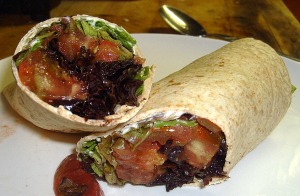Last week, like millions of other mutts all across America, I celebrated my fractional Irish heritage (in my case, the fraction is a respectable 1/4) by cooking a corned beef and a great, warm, buttery pot of colcannon–and then foisting them on my pizza-and-hot-dog-loving family. The children loved the meat, as well as the carrots I’d cooked along with it, and Daughter Dearest even scarfed down most of her colcannon. Who says that “you can’t even TASTE the green stuff!” isn’t a ringing endorsement?
In the following days, the corned beef was put to delicious use as sandwich innards; I had a couple of butter-soaked and Bacon Salt-ed bowls of colcannon late at night, when no one was looking. Nevertheless, I was left with an awful lot of leftovers–including half a large bag of kale. There also happened to be a few cans of white beans and some lovely Yukon Golds in my pantry, so it occurred to me that I might make a batch of caldo verde, or possibly some simple beans and greens. Or–and here inspiration started to gain momentum, like a runaway go-cart headed downhill–both. Together. Beans, greens, potatoes, chicken broth, garlic. With the leftover colcannon! Perfect!
And so was born my bizarre love child stew, the offspring of an Irish side dish, an Italian side dish and a Portuguese soup. Except it’s not bizarre at all, really; it’s rather serendipitous. Greens, garlic and potatoes are all elemental foods in many cuisines, and come together deliciously. The beans add a punch of protein, and the pureed part of the soup imparts creaminess, while leaving some chunks of potato and slivers of kale whole elevates this from the realm of pabulum or sickbed food.
Now, I’m assuming that you don’t have a giant container of leftover colcannon in your fridge, so I’m going to both scale this back and adapt it for scratch cooking.
Caldo Colcannon
6 large potatoes, peeled and cubed
1 onion, diced
3-4 cloves garlic, minced
smidgen olive or canola oil, or butter, or bacon fat
1 quart chicken broth
1 cup milk
1 can small white beans
1 lb. Kale, washed, chopped and blanched
parsley, if you have it on hand
1 T. lemon juice
Heat the olive oil together with the minced garlic in a large pan or stockpot. When it becomes fragrant, add the onion and potatoes; cook for a few minutes, stirring constantly to ensure that the garlic doesn’t burn. Add the broth and the kale. Lower heat to medium and simmer, for 20-30 minutes, until the potatoes are tender.
Remove several ladlesful of the soup and puree in a blender until smooth. Return to pot. Add milk, beans and remainder of the kale. Simmer for another 5-10 minutes. Add the parsley, if using, salt and pepper to taste, and the lemon juice. If the stew seems too thick, add more milk. Remove from heat and serve. If you like, garnish with cheese (parmesan or cheddar would be nice), bacon crumbles, scallions, or all of the above. Enjoy!








